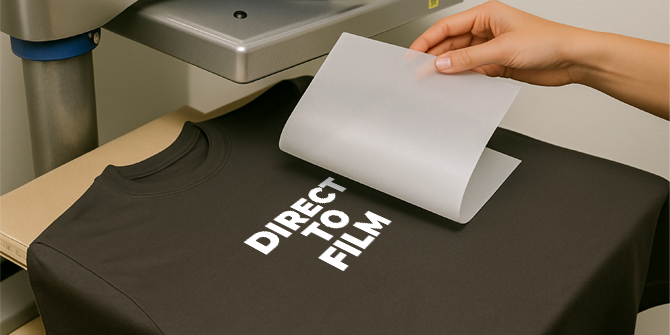What is Direct to Film (DTF) Printing?
Direct to Film offers full‑colour designs on a clear transfer film that can be heat‑pressed onto almost any fabric.

Direct to Film (DTF) printing is a fast-growing print method that uses specialised inkjet printers to create full‑colour designs on a clear transfer film, which is then coated with adhesive powder and cured. The finished transfer can be heat‑pressed onto almost any fabric, including cotton, polyester, and leather, without the need for garment pretreatment or weeding. The result is a vibrant, durable print that resists cracking, peeling, and fading — making DTF a versatile print for everything from custom apparel to promotional products.
Tips for Designing for Inkjet Printing
Use high-resolution images (minimum 300dpi)
Low-resolution artwork can look pixelated or fuzzy once printed and transferred. A 300dpi file ensures your design stays crisp, colours remain vibrant, and fine details are preserved.
Keep fonts at 8pt or larger
Tiny text can close up or become illegible after the transfer process. Using fonts at a minimum of 8pt ensures they remain sharp and readable once printed and heat-pressed, even on textured fabrics.
Outline all fonts (or embed them)
Outlining fonts converts text into shapes, locking in your chosen typography exactly as intended.
Avoid overlapping paths
Overlapping shapes and paths can confuse the printer, leading to unexpected gaps, edges, or printing errors. Combine elements into one clean, continuous graphic to avoid visible seams or misaligned layers.
Account for slight ink spread
During the heat transfer process, ink can spread fractionally on the fabric. Avoid designs with very fine details, tiny gaps, or closely spaced elements that could blur or merge. Leave a little breathing space in your design for the cleanest result.
Set non-print areas to transparent
DTF printing lays down a white ink base under your design for vibrancy. If “white” is used instead of transparent, that white will print, even if you didn’t intend it to. Make sure any background areas that shouldn’t print are fully transparent in your file.
Use vector graphics where possible
Inkjet printing can handle both vector and raster images. Vectors are ideal for logos and line art, while high-res raster images work perfectly for photos and complex illustrations. Just be sure everything is sharp and correctly scaled.